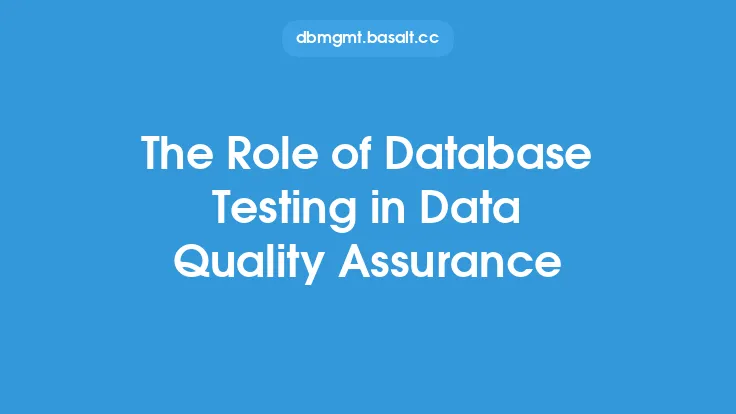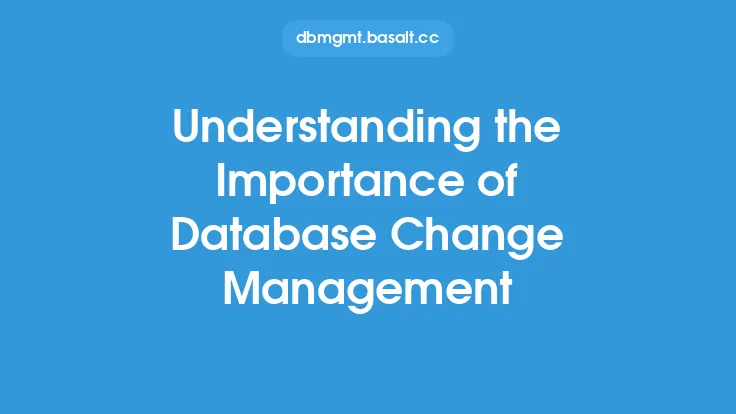Database testing is a critical component of the software development lifecycle, playing a vital role in ensuring the reliability and integrity of systems that rely on databases. As the backbone of most modern applications, databases store and manage vast amounts of data, making them a crucial aspect of system functionality. Database testing involves verifying that the database management system (DBMS) functions as expected, ensuring data consistency, accuracy, and reliability. In this article, we will delve into the importance of database testing in ensuring system reliability, exploring the various aspects of database testing and its significance in the software development process.
Introduction to Database Testing
Database testing is a type of software testing that focuses on validating the functionality, performance, and security of a database management system. It involves testing the database's ability to store, retrieve, and manage data, as well as its interactions with other system components. Database testing encompasses a range of activities, including data validation, query testing, transaction testing, and security testing. The primary goal of database testing is to ensure that the database functions correctly, efficiently, and securely, providing a solid foundation for the overall system.
Types of Database Testing
There are several types of database testing, each focusing on a specific aspect of database functionality. These include:
- Functional testing: Verifies that the database functions as expected, including data storage, retrieval, and manipulation.
- Performance testing: Evaluates the database's ability to handle large volumes of data and user traffic, ensuring optimal performance and responsiveness.
- Security testing: Identifies vulnerabilities and ensures that the database is secure, protecting sensitive data from unauthorized access.
- Recovery testing: Verifies the database's ability to recover from failures, such as data corruption or system crashes.
- Compatibility testing: Ensures that the database functions correctly with different operating systems, hardware configurations, and software applications.
Benefits of Database Testing
Database testing offers numerous benefits, including:
- Improved system reliability: By identifying and fixing database-related issues, database testing helps ensure that the system functions correctly and consistently.
- Data integrity: Database testing verifies that data is accurate, complete, and consistent, reducing the risk of data corruption or loss.
- Enhanced performance: Performance testing helps optimize database performance, ensuring that the system responds quickly and efficiently to user requests.
- Increased security: Security testing identifies vulnerabilities, reducing the risk of data breaches and unauthorized access.
- Reduced downtime: Recovery testing ensures that the database can recover quickly from failures, minimizing system downtime and reducing the impact on users.
Database Testing Techniques
Several database testing techniques are used to ensure the reliability and integrity of databases. These include:
- Black box testing: Tests the database's functionality without knowledge of its internal structure or implementation.
- White box testing: Tests the database's internal structure and implementation, using knowledge of the database's design and architecture.
- Gray box testing: Combines elements of black box and white box testing, using some knowledge of the database's internal structure to inform testing.
- SQL testing: Tests the database's SQL queries, ensuring that they are correct, efficient, and secure.
- Data masking: Masks sensitive data to protect it from unauthorized access during testing.
Challenges in Database Testing
Database testing poses several challenges, including:
- Complexity: Databases are complex systems, making it difficult to test all possible scenarios and interactions.
- Data volume: Large datasets can make testing time-consuming and resource-intensive.
- Security: Testing databases requires careful consideration of security risks, ensuring that sensitive data is protected.
- Performance: Testing database performance requires simulating real-world workloads and user traffic.
- Tooling: Database testing requires specialized tools and expertise, which can be costly and difficult to acquire.
Best Practices for Database Testing
To ensure effective database testing, several best practices should be followed:
- Develop a comprehensive testing plan: Identify testing objectives, scope, and timelines to ensure thorough testing.
- Use automated testing tools: Automate testing wherever possible to reduce manual effort and increase testing efficiency.
- Test early and often: Integrate testing into the development lifecycle, testing databases early and frequently to identify issues quickly.
- Use realistic test data: Use realistic test data to simulate real-world scenarios and ensure that testing is relevant and effective.
- Collaborate with developers: Work closely with developers to ensure that testing is aligned with development objectives and timelines.
Conclusion
Database testing is a critical component of the software development lifecycle, ensuring the reliability and integrity of systems that rely on databases. By understanding the importance of database testing, the types of database testing, and the benefits and challenges of database testing, organizations can develop effective database testing strategies that ensure the quality and reliability of their systems. By following best practices for database testing, organizations can reduce the risk of data corruption, improve system performance, and increase user satisfaction, ultimately ensuring the success of their applications and systems.





